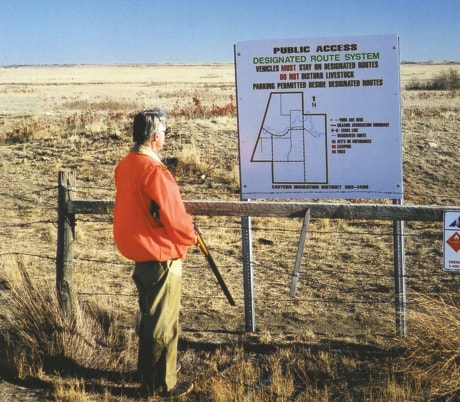As usual in September, just before Alberta’s upland game bird seasons open, I have been fielding the usual whines and complaints about “no place to go for wild birds,” and why can’t the government plant more hatchery birds in the dump sites, etc. etc., so that it is worthwhile for a person to train a bird dog and keep it all year?
Well, as I never tire of pointing out, there are still many landowners in Alberta’s prime pheasant, Hun and sharp tail country willing to grant permission to hunters who ask politely, behave themselves while hunting, and say thank you when they are through.
More importantly, there are now thousands of acres, more than ever before in Alberta’s history, where all manner of lawful outdoors recreations, including hunting, may be done without asking anyone’s permission.
For many years now, the largest of these areas has been the 600,000 acres of grazing lands, etc., in the Eastern Irrigation District around Brooks that remain private land in the name of the EID.
Many years ago, in an act of stunning foresight and generosity for which I am eternally grateful, the board of the EID opened these lands to recreational users, including hunters, who were prepared to abide by a very short list of simple, sensible rules.
Last year a new management initiative was added: hunters should go to the EID offices on the south side of Brooks and obtain the free Authorization to Access for Hunting. On my mid-September trip to Brooks I slipped by the EID to get my Authorization, because I wish to continue to enjoy roaming, hunting and fishing this vast tract of land. It is not clear what happens to any hunter found on this land without the authorization, and Rick Martin, EID Wildlife Projects Manager, has not been available to tell me and also answer a couple of other questions I have.
The only information I was required to give for my Authorization was my name and telephone number. In view of the Public Access Guidelines (the rules), I suggest it would be useful also to require hunters to list their vehicle(s) licence number(s) and what Alberta hunting licences they hold.
When I talked to Rick Martin last year, he told me that a major purpose of the Authorization was to find out precisely who and generally how many hunters were using the land and to rule out ignorance as any excuse for violations of the rules. In that, the Authorization is similar to the free fishing licence introduced in the early 1960s when the great catch and release experiment started in Yellowstone Park.
The clear and simple Public Access Guidelines are printed on the back of the EID Access Authorization: Do not disturb livestock and no hunting permitted near livestock (livestock is removed for most, but not all of the hunting season); all vehicles must stay on established roads or designated routes where posted — no exceptions — no ATVs or motorbikes allowed; obey all signs; leave gates as you find them; no open fires; no camping except in designated areas; pets must be supervised and kept under control at all times.
In the unlikely event that the nice lady at the counter forgets, every applicant for the Authorization should be sure to ask for a copy of the excellent Wildlife Guide, published by the EID.
It contains four quadrant maps of the EID showing the grazing-lease-community pasture lands, the wetlands on it, the main trails, and a general indication of where the waterfowl, upland bird and big game (deer and antelope) habitat is located and where sport fishing is to be found and where camping and boat launching is permitted.
A bonus of the maps is that nine private land Wildlife Habitat Properties in the EID are shown, on most of which hatchery pheasants are regularly planted in season, and all of which I avoid like the plague in favour of chasing wild birds on the vast EID land, or on other private land where I ask and receive the landowner’s permission.
The truly wise hunter will stop by the County of Newell office in the south-east corner of Brooks to obtain a copy of the latest, large landowner (including EID land) map.
The final paragraph of the EID’s Public Access Guidelines says it all: “The EID manages its land and water with a multi-use philosophy which benefits everyone. By adhering to these basic access rules on EID owned lands and asking permission to access other private lands you are investing in the future.
Please remember that access to these private lands is a privilege, not a right. ‘Use Respect’ and enjoy your visit to the Eastern Irrigation District.”
Amen.
The EID’s board and staff should go straight to heaven, without having to pass “Go.”
So, gents, quit whining to me about having no place to go to let your dog stretch out chasing wild upland game.
Bob Scammell is an award-winning outdoors writer living in Red Deer.
